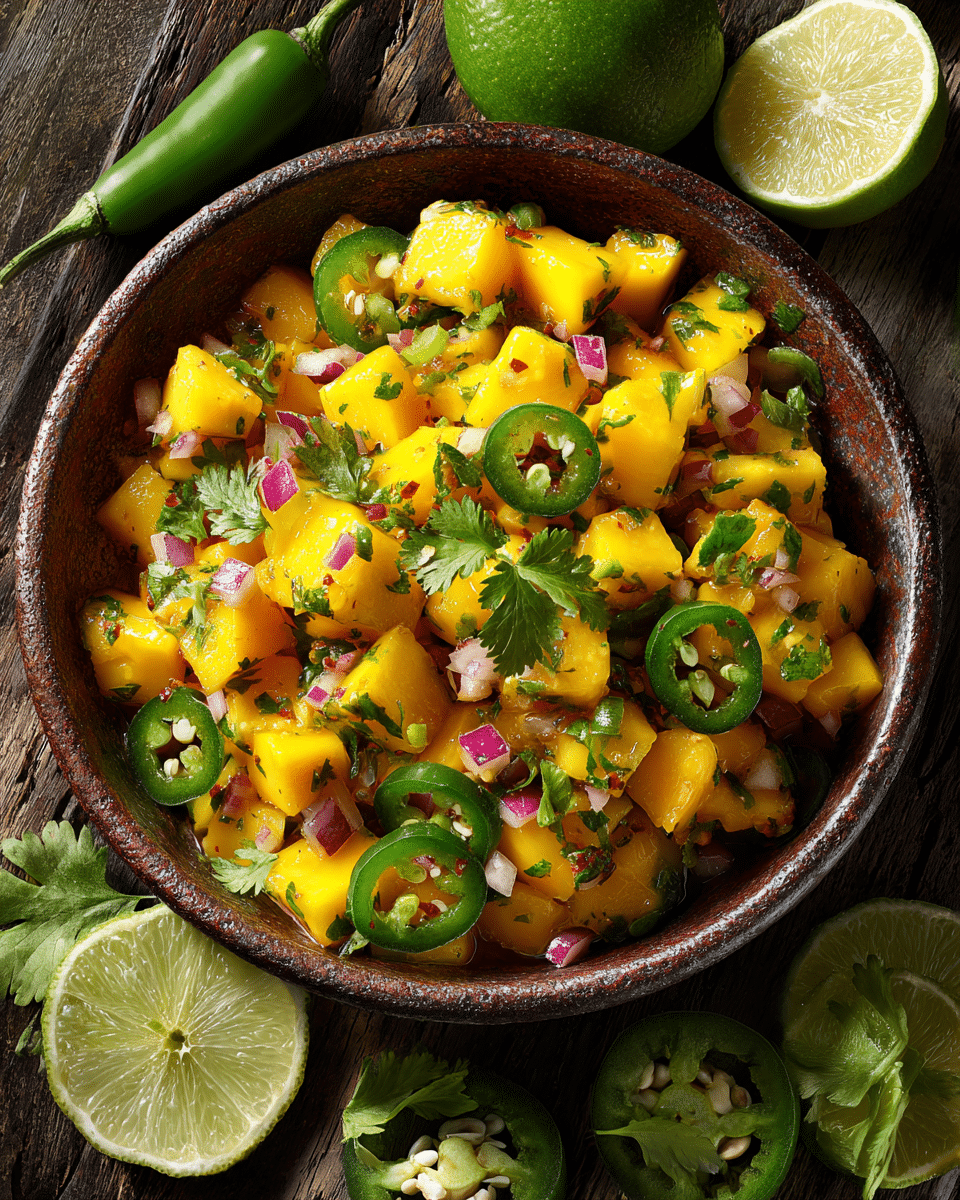
Table of Contents
Mango season calls for something bright, juicy, and just a little bit fiery — and that’s exactly what this Tropical Mango Salsa Recipe delivers. Bursting with the sweetness of ripe mangoes, the zing of fresh lime, and a subtle heat from jalapeño, it’s the kind of dish that instantly makes any summer meal feel like a tropical getaway. Whether you’re serving it with grilled fish, crispy tortilla chips, or spooned over tacos, this salsa will quickly become a go-to in your kitchen. And if you’re a true mango lover, don’t miss our mango ice cream recipe for another sunny, fruit-forward treat.
What Makes This Tropical Mango Salsa Recipe Special
The Perfect Summer Appetizer
When the days are long and the temperatures climb, you want food that’s fresh, light, and full of flavor. Tropical mango salsa ticks all those boxes. Its vibrant color alone makes it a showstopper on any table, but the real magic is in how its flavors work together. The sweetness of the mango is balanced by tart lime juice, the brightness of fresh herbs, and the gentle burn of jalapeño. This balance means it works just as well as a starter with chips as it does as a topping for grilled seafood, chicken, or even a juicy burger.
Flavor Profile: Sweet Mango Meets Spicy Jalapeño
This salsa isn’t just sweet — it’s layered. The mango delivers a rich, honey-like sweetness, while diced jalapeño brings just enough heat to keep your taste buds awake without overwhelming them. Red onion adds a mild bite, cilantro brings freshness, and a hint of toasted coconut gives a subtle nutty note that elevates the dish from simple to unforgettable. Every bite is a quick vacation for your senses, making it the kind of recipe you’ll want to serve at every summer gathering.
Key Ingredients for the Best Mango Salsa
Fresh Mango Varieties to Use
Not all mangoes are created equal, especially when it comes to salsa. For a tropical mango salsa that’s juicy but still holds its shape, go for varieties like Ataulfo (Honey) or Kent mangoes. These types are naturally sweet, have a smooth, non-fibrous flesh, and a vibrant golden color that makes your salsa pop visually. Avoid mangoes that are overripe and mushy, as they’ll make the salsa watery and less appealing in texture. If you enjoy exploring other tropical fruits in your recipes, you might also love the juicy twist in our modern ambrosia salad recipe — a colorful, fruit-forward dish perfect for summer.
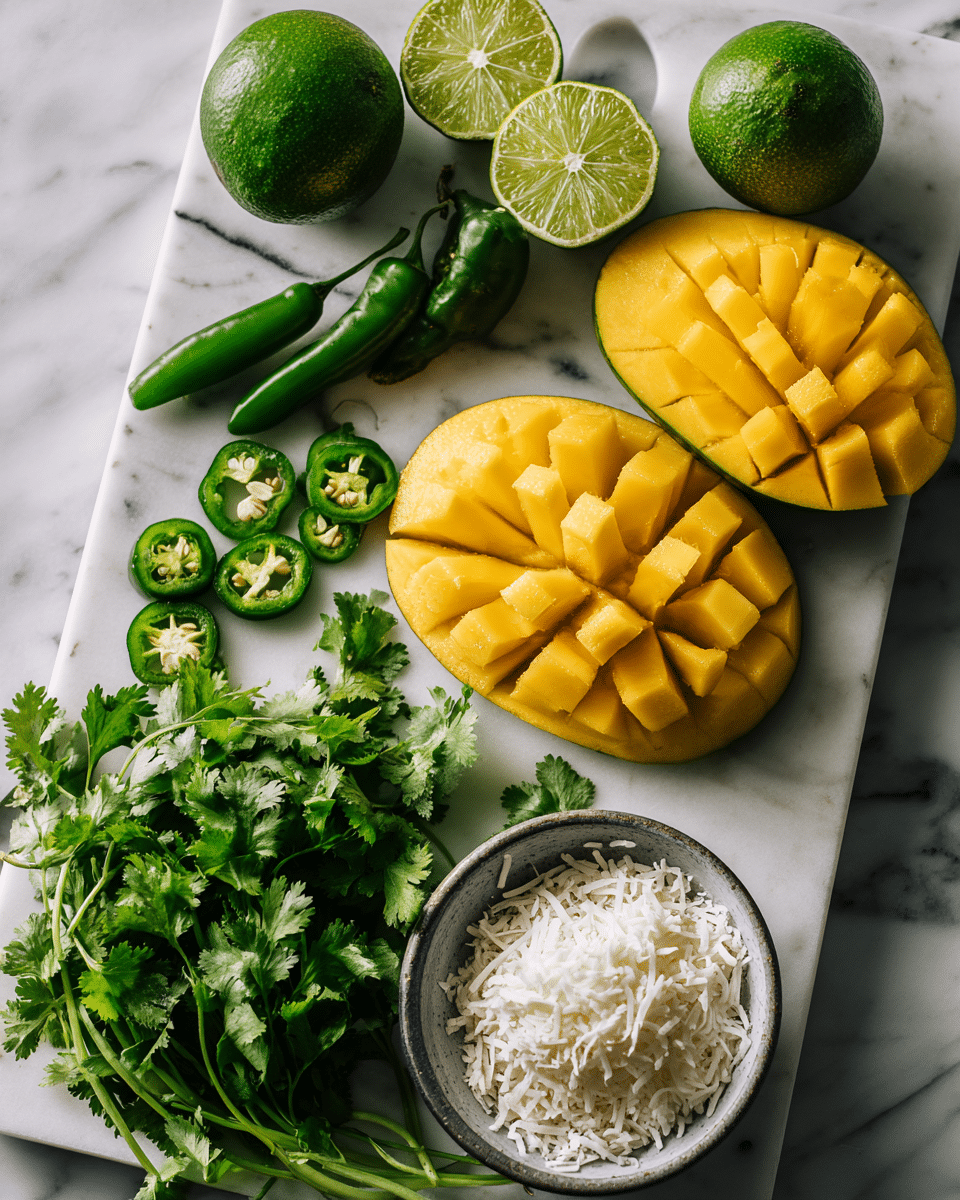
Essential Herbs, Spices & Citrus
A great mango salsa is more than just fruit; it’s a balance of sweet, tangy, and spicy flavors. The essentials include:
| Ingredient | Role in Flavor |
|---|---|
| Fresh cilantro | Adds herbal freshness |
| Jalapeño | Provides heat and spice |
| Red onion | Gives sharpness and crunch |
| Fresh lime juice | Brings brightness and acidity |
| Toasted coconut flakes | Adds tropical nuttiness |
The key is to chop everything uniformly so each bite is perfectly balanced. And if you like pairing sweet with a touch of savory, our rustic peach galette offers another great example of how fruit can shine in unexpected ways.
Step-by-Step Preparation Guide
How to Cut Mango for Salsa
The key to a visually appealing salsa is clean, uniform mango cubes. Start by standing the mango upright and slicing off the two “cheeks” alongside the pit. Score the flesh in a grid pattern without cutting through the skin, then invert the cheek so the cubes pop out. Use a paring knife to carefully trim them away. Repeat with the other cheek and remove any extra fruit from around the pit. Consistency in size ensures the mango blends evenly with the other ingredients, giving you that perfect scoopable texture.
If you want more fruity creativity in the kitchen, try our chocolate chips and strawberry salsa — an unexpected twist that proves salsa isn’t just for savory flavors.
Mixing & Balancing Flavors
Once your mango, onion, jalapeño, and herbs are prepped, combine them in a large mixing bowl. Pour over the lime juice, sprinkle with a pinch of salt, and gently toss to coat without crushing the mango pieces. Taste as you go — you can always add more jalapeño for heat or more lime for brightness. For an extra depth of flavor, try toasting your coconut flakes until golden before folding them into the mix. This step not only enhances aroma but also adds a delightful crunch.
Looking for another way to mix sweet and savory? Check out our swicy baked feta — a warm, bold dish that uses spice in a completely different way but still complements tropical flavors beautifully.
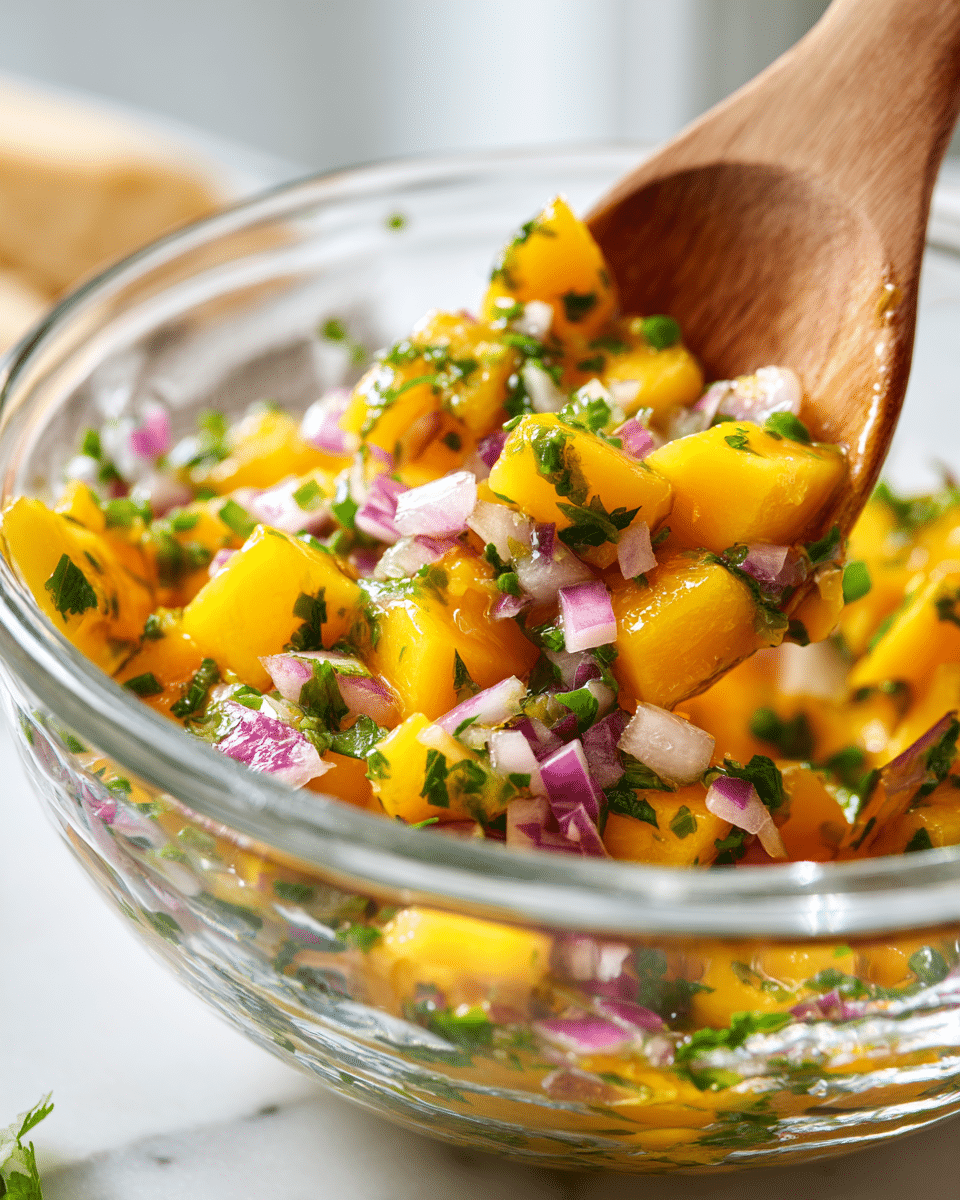
Serving Ideas & Pairings
Best Dishes to Serve with Mango Salsa
One of the most appealing qualities of tropical mango salsa is its incredible versatility. It works as a vibrant appetizer, a refreshing topping, or even a bold side dish — effortlessly fitting into casual get-togethers, holiday feasts, and elegant dinner menus. The sweet heat from the mango and jalapeño combination can elevate almost any protein or plant-based dish. Here are some of the best ways to serve it:
- Grilled fish – Mahi-mahi, tilapia, snapper, or salmon benefit greatly from the sweet-spicy lift of tropical mango salsa. The caramelization from grilling pairs beautifully with the freshness of the fruit. A spoonful on top just before serving locks in both flavor and presentation.
- Tacos – Whether it’s fish, shrimp, chicken, or even pulled pork, a generous scoop of mango salsa adds freshness, crunch, and tropical flair. The salsa’s juicy texture contrasts perfectly with crispy taco shells or soft tortillas.
- Roast chicken – Juicy, herb-roasted poultry becomes even more exciting when served with a side of tropical mango salsa. The acidity of lime juice in the salsa cuts through the richness of the chicken.
- Chips and crackers – Sometimes, simplicity wins. Serve the salsa in a colorful bowl with a selection of tortilla chips, plantain chips, or even seedy crackers for an easy, crowd-pleasing appetizer.
- After-spice dessert pairing – If your meal leans on the spicy side, follow it with something cooling and creamy like our Mexican ice cream. It’s a playful way to finish a bold dinner on a sweet, refreshing note.
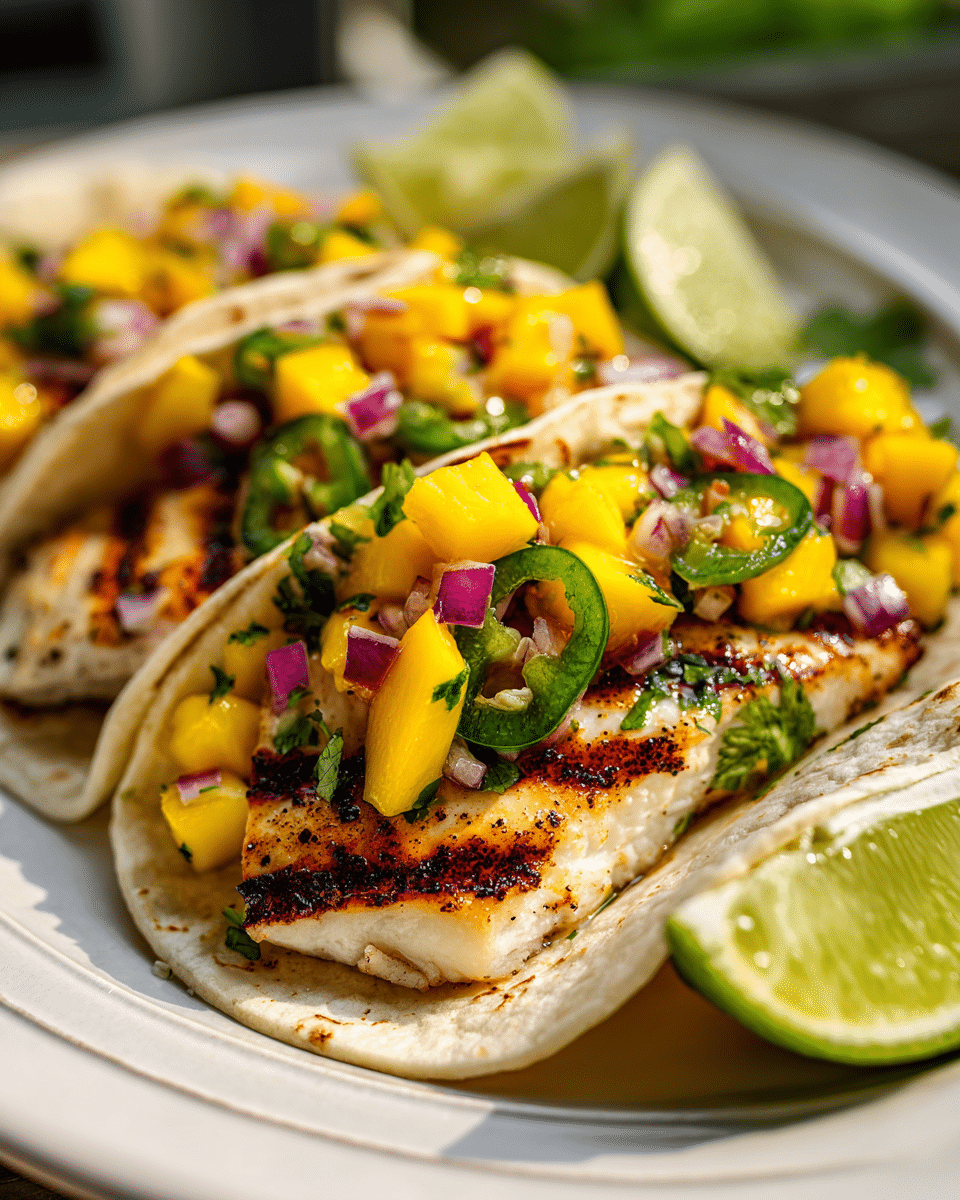
Creative Tropical Pairings
If you’re feeling adventurous, tropical mango salsa can also shine in more unexpected culinary settings:
- Over grilled pineapple rings – This doubles down on the tropical vibe, giving you a layered sweetness with smoky, caramelized undertones.
- With coconut rice – The toasted coconut in the salsa complements fluffy coconut rice, creating a side dish that’s both rich and refreshing.
- As a topping for burrata – The creamy, mild flavor of burrata pairs surprisingly well with the bright, fruity notes of mango. Add a drizzle of honey or balsamic glaze for a sophisticated appetizer.
- With a fruit-forward galette – Pair it with a peach, nectarine, or apricot galette for a playful sweet-meets-savory dessert plate. The salsa acts almost like a fresh chutney, bringing acidity to balance the pastry’s richness.
The beauty of this tropical mango salsa recipe is that it bridges the gap between savory entrées and fruity desserts. You can keep it traditional or experiment with bold, creative combinations — either way, it will bring a pop of color, freshness, and flavor to your table.
Storage & Make-Ahead Tips
How Long Mango Salsa Lasts
Fresh tropical mango salsa tastes its absolute best right after you make it — the mango is still firm, the herbs are crisp, and the lime juice is bright and zesty. Ideally, you’ll serve it within the first 24 hours, when all the textures and flavors are at their peak. That said, if you prepare more than you can finish, you can store it safely in the refrigerator for up to 3 days without significant flavor loss. Over time, you’ll notice the mango softening and the herbs wilting slightly. The lime juice will continue to mingle with the other ingredients, which can create a more uniform flavor but may also make the salsa a little juicier.
If you know in advance that you won’t be serving the salsa right away, there’s a smart approach: chop the mango, onion, jalapeño, and any other add-ins in advance, but wait to add the lime juice and cilantro until just before serving. This way, you lock in that just-made freshness and keep the colors vibrant.
Best Containers for Freshness
The container you choose can make or break the shelf life of your mango salsa. Airtight glass containers are the gold standard because they seal in aroma, resist staining, and won’t absorb the salsa’s natural oils or citrus tang. If you don’t have glass, choose BPA-free plastic with a tight seal, but avoid long-term storage in plastic, as it can retain strong onion or jalapeño aromas.
To go the extra mile, place a piece of parchment paper or plastic wrap directly on the surface of the salsa before closing the lid. This step minimizes air exposure, which helps prevent oxidation and keeps the mango from browning.
Can You Freeze Mango Salsa?
Technically, yes — but freezing isn’t recommended if you want the texture to shine. Mango tends to lose its firm, juicy bite when thawed, turning softer and slightly mushy. The herbs will also darken and lose their fresh aroma. If you must freeze, consider making the salsa without the herbs and adding fresh cilantro after thawing to bring back some brightness.
Make-Ahead Tips for Parties and Gatherings
If you’re planning to serve tropical mango salsa for a summer cookout, beach picnic, or holiday spread, you can save yourself time with a simple prep plan:
- Chop the mango, onion, and jalapeño up to 24 hours ahead and store each in separate airtight containers in the fridge.
- Toast your coconut flakes in advance and keep them in a sealed jar at room temperature so they stay crisp.
- On the day of serving, simply combine everything with freshly squeezed lime juice and chopped cilantro about 30 minutes before guests arrive. This gives the flavors just enough time to blend while keeping the salsa bright and lively.
Following these tips means you can enjoy a salsa that tastes as if you just made it, without rushing in the kitchen during the event.
FAQs About Tropical Mango Salsa
What are the ingredients for mango salsa?
A classic tropical mango salsa usually includes fresh ripe mango, jalapeño, red onion, cilantro, lime juice, and a pinch of salt. For a tropical twist, you can also add toasted coconut flakes, diced pineapple, or even avocado. The key is balancing sweet, spicy, and tangy elements.
Where did mango salsa originate?
Mango salsa is inspired by the broader Latin American tradition of fruit-based salsas, which blend sweet tropical produce with chili heat and citrus brightness. While no single country claims exclusive origin, it’s most often linked to Mexican coastal cuisine, where mangoes grow abundantly and are paired with seafood.
How does mango salsa taste?
It’s a burst of flavors — sweet from the mango, zesty from the lime, a little fiery from the jalapeño, and fresh from the cilantro. When you add toasted coconut or other tropical fruits, you also get nutty and floral notes that make each bite layered and exciting.
Which mango is best for salsa?
Ataulfo (Honey) and Kent mangoes are favorites because they’re naturally sweet, low in fibers, and hold their shape well after cutting. Tommy Atkins mangoes are more widely available but tend to be more fibrous, so they work best if chopped extra small.
Conclusion – Why You’ll Love This Tropical Mango Salsa Recipe
A tropical mango salsa recipe isn’t just another dip — it’s a flavor experience that captures the essence of sunny days, ocean breezes, and vibrant summer gatherings. The sweet juiciness of perfectly ripe mango, the zesty brightness of fresh lime, the gentle kick of jalapeño, and the herbal lift of cilantro all work together to create a salsa that feels both refreshing and indulgent.
What makes this recipe truly special is its adaptability. Serve it as a quick snack with chips for an easy weeknight treat, or dress it up alongside grilled seafood, tacos, or roast chicken for a show-stopping main course. It even shines in unexpected pairings — from creamy burrata starters to tropical-inspired desserts.
Because it’s so colorful and inviting, this tropical mango salsa instantly elevates the look of any spread, making it a hit for parties, picnics, and barbecues. Plus, with simple prep steps and easy-to-find ingredients, it’s a dish you can whip up in minutes without sacrificing freshness or flavor.
Whether you’re a seasoned home cook or just dipping your toes into fresh summer recipes, tropical mango salsa is one of those rare dishes that feels both exciting and comforting every single time you make it. Keep it in your rotation, and you’ll have a guaranteed crowd-pleaser ready for any occasion.
Craving more edible art? Follow my culinary adventures on Facebook and save your next masterpiece on Pinterest!
Print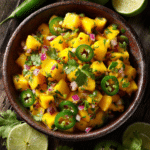
Tropical Mango Salsa Recipe – Fresh, Sweet & Spicy Summer Favorite
- Total Time: 15 minutes
- Yield: 4 servings
Description
Fresh tropical mango salsa recipe with ripe mango, spicy jalapeño, zesty lime, red onion, cilantro, and toasted coconut. Perfect for tacos, fish, chicken, or chips.
Ingredients
2 ripe Ataulfo or Kent mangoes, diced
1 jalapeño, minced
1/2 small red onion, diced
1/4 cup fresh cilantro, chopped
Juice of 1 lime
1/4 cup toasted coconut flakes
Pinch of salt
Instructions
1. Dice the mango into small cubes.
2. Chop the jalapeño, onion, and cilantro.
3. Combine all chopped ingredients in a large mixing bowl.
4. Add lime juice and salt to taste.
5. Toss gently to mix without crushing the mango.
6. Serve immediately or store in an airtight container for up to 3 days.
Notes
Use Ataulfo or Kent mangoes for best flavor and texture.
Adjust jalapeño to your preferred spice level.
Toast coconut flakes in advance for added crunch and aroma.
Prep ingredients ahead and mix just before serving for freshness.
- Prep Time: 15 minutes
- Cook Time: 0 minutes
- Category: Appetizer, Side Dish
- Method: No Cook
- Cuisine: Mexican, Tropical
